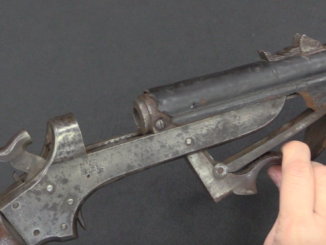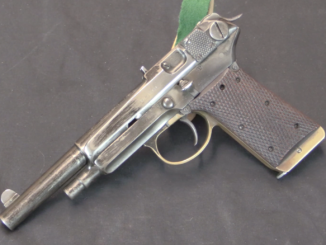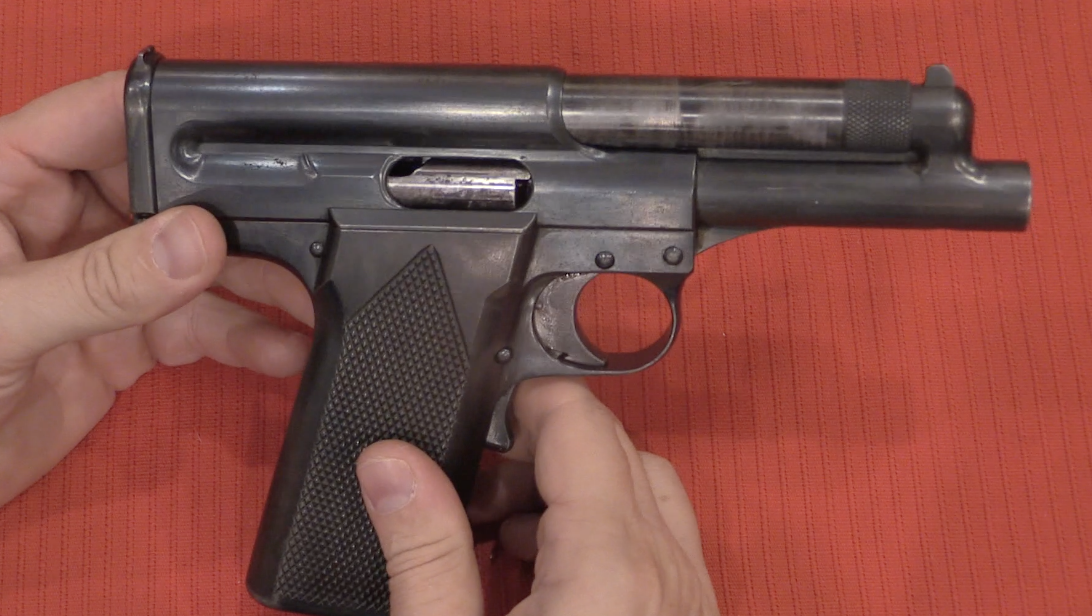The Model 1871 Ward-Burton was one of the early experimental rifles trialled by the US military in its search for a new breechloading rifle to replace the theoretically-interim Allin conversion that made muzzle-loading rifles into Trapdoor Springfields. Four breechloading cartridge rifles were selected for field trials in the early 1870s: the Sharps, the Trapdoor Springfield (as a control), the Remington Rolling Block, and the Ward-Burton bolt action. It was a single-shot design, and the only one of the trial designs that would not have already been relatively familiar to US troops at the time. While the bolt action system is ubiquitous today, it was quite novel in the 1870s.
Mechanically, the Ward-Burton was fairly standard by today’s standards, although it used two sets of interrupted threads at the rear of the bolt for locking, rather than the two large front lugs preferred today. The names associated with it are two US Generals, William Ward and Bethel Burton. Ward held a patent on the bolt action system the rifle used (US Patent 81,059), and Burton held a patent on the extractor/ejector mechanism (US Patent 99,504). In total, 1013 Ward-Burton rifles (32 1/8″ barrel) and 313 carbines (22″ barrel) were manufactured by Springfield chambered for the then-standard .50-70 cartridge, and issued to a variety of units. These included the 13th Infantry and 1st, 3rd, 4th, 5th, 6th, 7th, and 9th Cavalry companies.
Ultimately, of the 95 field reports filed on the different rifles in these trials, not a single one recommended the Ward-Burton for adoption. The guns had a few mechanical issues (including heat treat problems with the bolts), but more significant seems to have been the general unfamiliarity of the bolt system with troops. The Trapdoor Springfields, Rolling Blocks, and Sharps rifles all had vary prominent manually-cocked hammers that would clearly communicate whether the rifles were ready to fire. The Ward-Burton bolt had a modern-type internal striker, and no obvious outward indication of loaded/unloaded/cocked/uncocked status. This led to soldiers being uncomfortable with the guns, and more than a few accidental discharges. This would not be such an issue today, I suspect, but it was enough to prevent the Ward-Burton from seeing any further use by the US military at the time.




With no indicator of firing status on the bolt, I can imagine that someone would eventually scream “AH! I JUST SHOT MARVIN IN THE KNEE!” Later bolt-actions would have an indicator on the rear of the bolt. And at least two earlier bolt-action rifles in Europe had to be cocked manually before chambering a round to prevent accidental discharge. Am I right?
Apparently the Swiss, who already had the Vetterli, would laugh at America for fumbling around with trapdoor actions.
“And at least two earlier bolt-action rifles in Europe had to be cocked manually before chambering a round to prevent accidental discharge. Am I right?”
Yep. The Dreyse “needle gun”, its opposite number the Chassepot, and the Gras and Mauser ’71 metallic cartridge single-shots developed from them, all had to have their strikers cocked by hand before the bolt would open. This, BTW, was the nearest thing to a “safety” on any of them.
Their repeating successors also lacked safeties. The 71/84 Mauser and the Kropatschek tube-magazine repeaters had magazine cutoffs, as did the Lebel tube repeater. (All of these cocked the striker automatically when the bolt was closed, IIRC. Anybody?)
These cutoffs locked the Winchester-style cartridge lifter in the “up” position, so it could act as a loading tray for single-loading the breech. The idea being to use the rifle as a single breechloader, saving the repeating function for when very rapid fire was necessary.
I think most sensible modern shooters dealing with these old soldiers would probably be well advised to use the cutoff as a de facto safety, and leave them in Condition Three (empty chamber, loaded magazine) until ready to shoot.
cheers
eon
Even later French service repeating rifles have not manual safety.
Berthier and MAS-36 have not manual safety.
http://forums.gunboards.com/showthread.php?8886-Berthier-carbine-with-factory-safety
I believe the best safety there is can be found between your ears. Relying on any mechanical safety is a sure way to be negligent. I don’t use the safeties on any of my guns, I simply do not load them (not even the magazine) until I’m ready to shoot, and I only load as many rounds I actually intend to shoot.
Regarding the above rifle, very nice piece. Looks like a miniature artillery gun with those interrupted threads.
Any relation to the Bethel-Burton magazine rifle?
I realize that Burton is a very common surname.
D’oh!
Just re read the piece, Bethel was Burton’s first name.
Interesting gun. althou it did mot peeform very well, I will take one anyway
I don’t think “performance” is a criteria for a collectible. The GREENE (1857 patent) was a terrible rifle – never got out of trials! But they are scarce and represent a piece of US military history – and I own one !
Very neat. A big jump from the wartime muzzle loaders of just 6 years before.
I have a pretty nice collection of antique military weapons, including Civil War. I would NEVER shoot my collection, but do own shooters. Why would anyone take a chance on damaging a 150 year old gun worth thousands, or worse damaging your brain with a chunk of receiver steel sticking in it? I own WW1 guns also, including the four gun 1911 commeratives. I read a posted comment on this set – one guy wrote “boy Packy grips sure improved the shooting of this pistol” I wanted to write back and say congratulations you just turned a $1000 gun into a $500 gun!